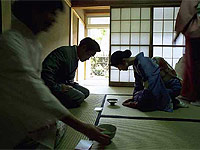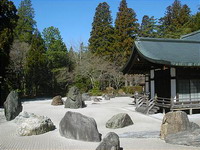Tea ceremony (part 2)
 TEA ORGANIZATION
TEA ORGANIZATION
Don’t speak words
Guest, host
White Chrysanthemum.
Tea ceremony The tea ceremony is surrounded by a special atmosphere, which the Japanese call “Wa”. In everything, from the garden and the tea house built in it to the decoration of the tea room, everything was created in order to give rise to a certain state of mind.An outdoor garden with mossy stones and an overgrown pond represents a nature that is free from human intervention, and a tea house with props made of uncouth wood or bamboo and a low thatched roof is a natural extension of it. In the tea room, twilight reigns, time here seems to have stopped. All items intended for the tea ceremony have a strictly defined shape, color and texture. Their number is also strictly determined by tradition. Each of them bears the imprint of antiquity, with the exception of only a linen tablecloth and a bucket made of cut bamboo, which always remain deliberately new and fresh. The whole atmosphere of the tea house is designed to distract from the hustle and bustle and bring to a state of peace and tranquility.
The Japanese believe that if the passions raging in the human soul give rise to certain gestures, then there are also gestures that can affect it. Strictly defined measured movements of the tea ceremony create peace in the soul and bring it into a state of equilibrium. Arising from a special ritual of tea drinking, which was practiced by Zen monks, the art of the tea ceremony is considered as one of the ways to comprehend the true meaning of life.
Tea ceremonyThe preparation and organization of the tea ceremony is in accordance with tradition. First of all, the owner carefully considers the list of guests and sends invitations to each of them, indicating the time and place of the tea party, its type and composition of guests. Particular attention is paid to the choice of the main guest, who should be a respected person who is well acquainted with the ritual of the tea ceremony. At the ceremony, guests are in appropriate clothing. If the tea ceremony is formal, then men, as a rule, wear a silk kimono, a black haori wrap, wide hakama harem pants and a white tabi belt (belt) of white color. Women’s clothing should not be bright.
As a rule, no more than five people attend the ceremony. At the entrance to the tea house, the hostess greets guests with a bow. Even if the ritual takes place during the day, twilight should reign in the tea room. The ceremony lasts about 4 hours and consists of three stages: eating, drinking “thick”, and then “liquid” tea. It is the responsibility of the host to prepare and serve tea for those present. Powdered tea powder is poured with hot water and whipped into a lush foam. This tea is much stronger than usual for Europeans. No more than three sips of the drink are poured into the guest’s cup. It should be taken with special movements, after which the guest should thank the owner. Conversations during the tea ceremony were not accepted, and only after the first sip is it allowed to ask a question about the dishes, the master who made them, to speak well about the quality of tea, etc.
Over the centuries-long history of the tea ceremony, seven types of tea drinking have developed:
“Tea action in the morning.”
“Tea action at noon.”
“Tea action at night.”
“Tea action with sweets.”
“Tea action beyond a certain time.”
“Tea action at dawn.”
“Tea event, organized for those who came after the” main tea party. ”
Tea ceremony The classic Japanese tea ceremony is based on four principles, each of which has deep historical and cultural roots. The principle of harmony implies the existence of an internal unity between the participants in the tea party, which helps them become one. Each participant in the tea party should pay respect to the other guests and the ceremony itself. The third principle implies the purity of thoughts and the absence of selfish goals. An indispensable condition for participating in the tea ceremony is also a state of rest, the achievement of which, in fact, the previous principles are aimed at.
According to Kikuzo Okakura, in the eyes of a foreign inhabitant, the tea rite is just an example of “a thousand and one oddities that make up the incomprehensibility and childishness of the East.” However, before making hasty conclusions, it is worth thinking about how, in essence, “the cup of human joys is small and how wise those who know how to fill it.” In the view of the Japanese, a person who knows how to live sees the joys of life where others do not notice them. The tea ceremony teaches you to find beauty in the ordinary, to be content with little, to find a connection between nature, art and everyday life.
The tea ceremony opens the door for us to another world with its own traditions and laws, without which it is impossible to understand the nature of the Japanese people and to form a complete picture of the country. This unusual ritual reflects the desire for harmony and balance and teaches us to look at the world in accordance with the attitude of Zen.



